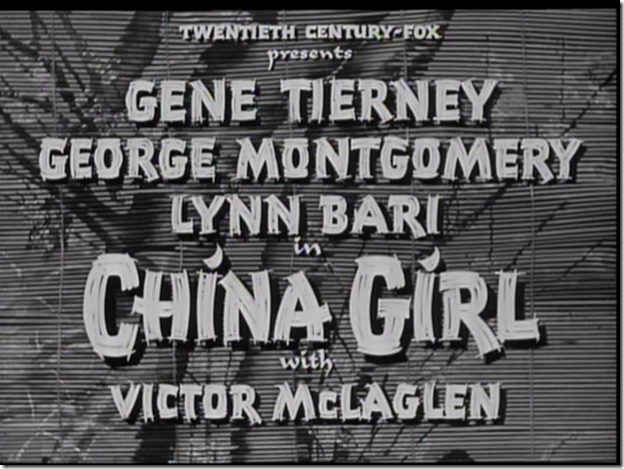
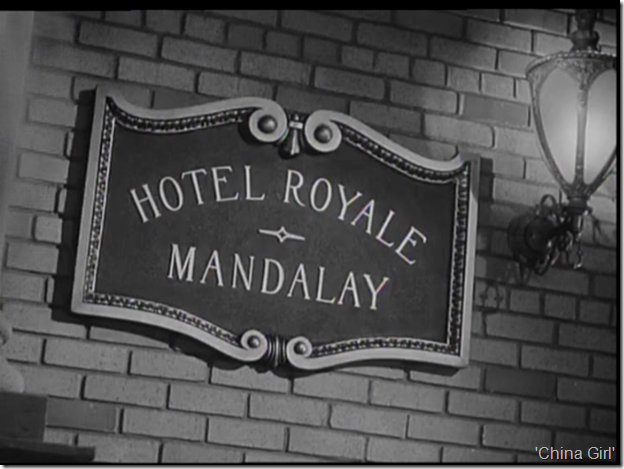
This is an establishing shot from the 1942 feature “China Girl,” which was obviously filmed in the Bradbury Building. Or was it?
[Update: If this is a set, as it appears to be, where did Twentieth Century-Fox build it? People talk about the height of the set for “Rear Window,” but this interior appears to be three or possibly four stories tall — although I would imagine there could have been some trickery involved, like forced perspective or matte shots. A puzzlement.]
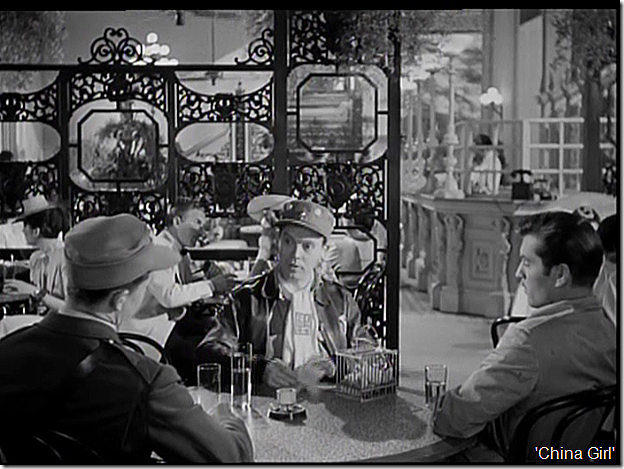
Here are some shots set in the bar. Notice the registration desk in the background.
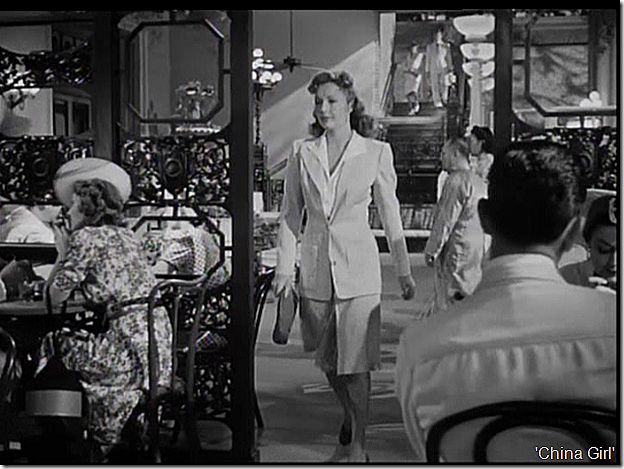
Here’s the entrance to the bar, showing the registration desk and a half-flight of stairs.
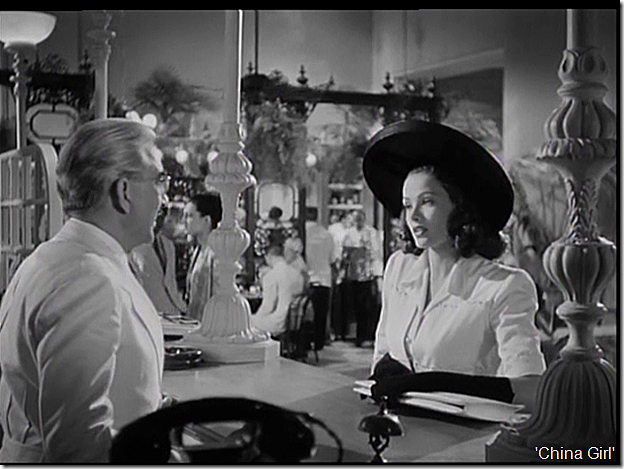
This is the registration desk….
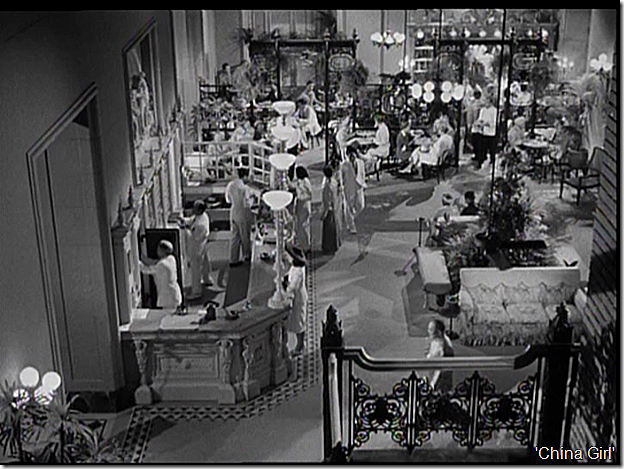
And here’s an overall shot of the lobby. I got to wondering whether this is a set. It seems to be too big for the Bradbury lobby.
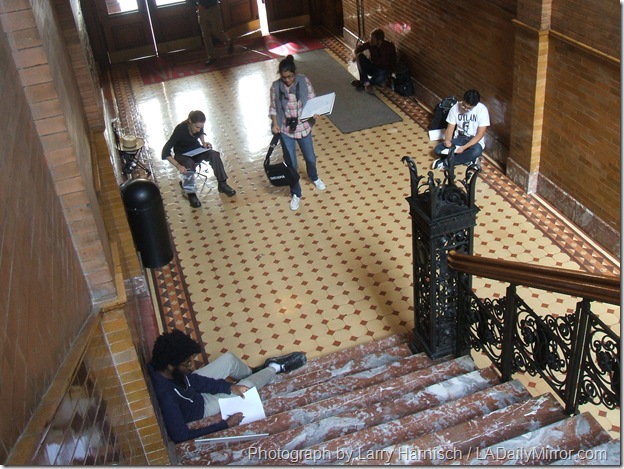
For comparison, here are photos I took of Marion Eisenmann’s class in the Bradbury lobby last year. Look how much narrower it is.
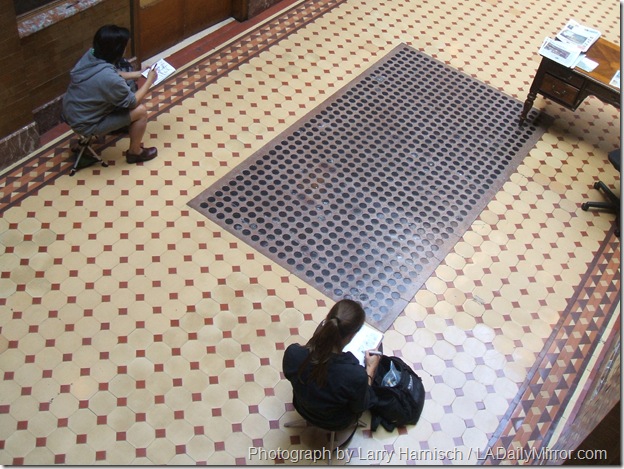
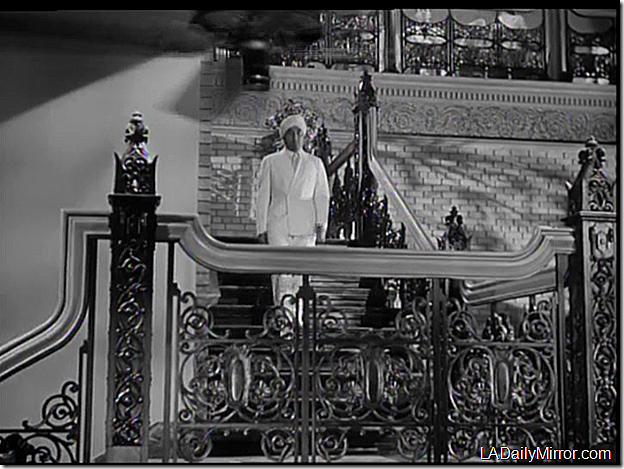
When I saw this ironwork, I was sure this was the Bradbury building. But wait a minute….
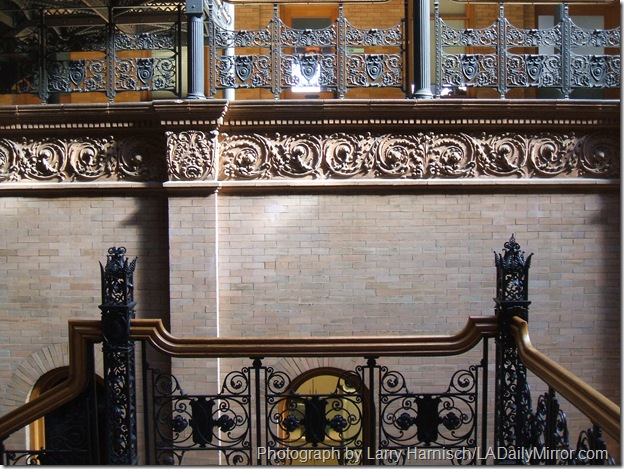
And here’s a shot of the actual ironwork.
 |
 |
Uh-oh. They don’t match.
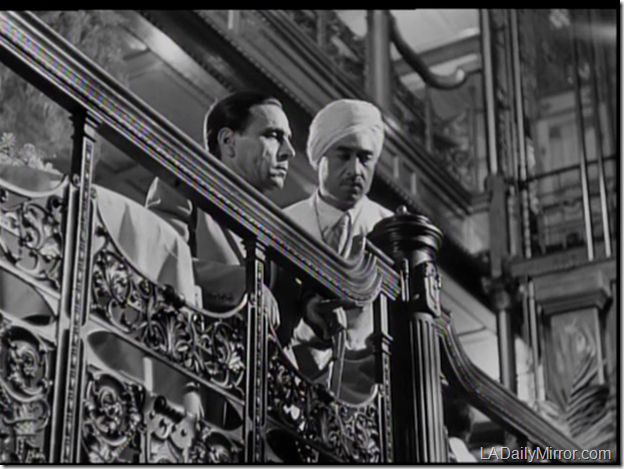
So what about this shot? It looks like the Bradbury Building, with the elevator in the background. But it wouldn’t make sense to film most of the scenes on a set and go to the Bradbury for a couple of pickup shots.
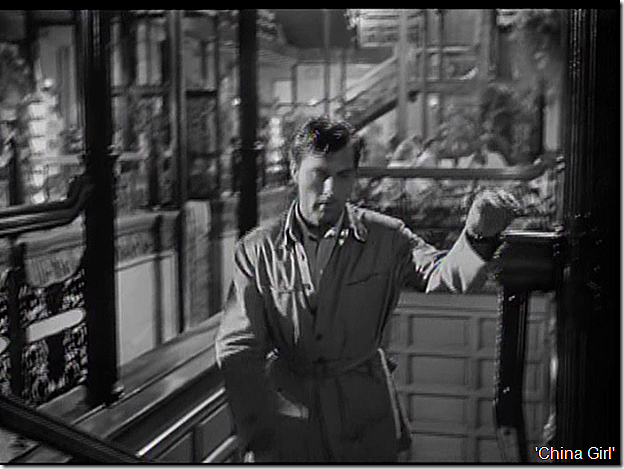
This looks like the Bradbury Building… but is it?

And how about this shot?
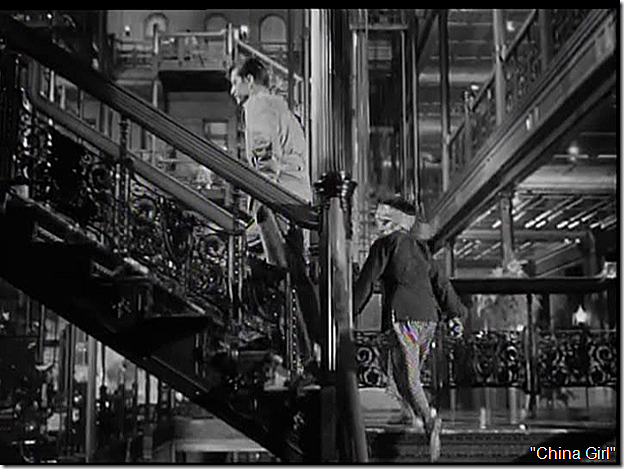
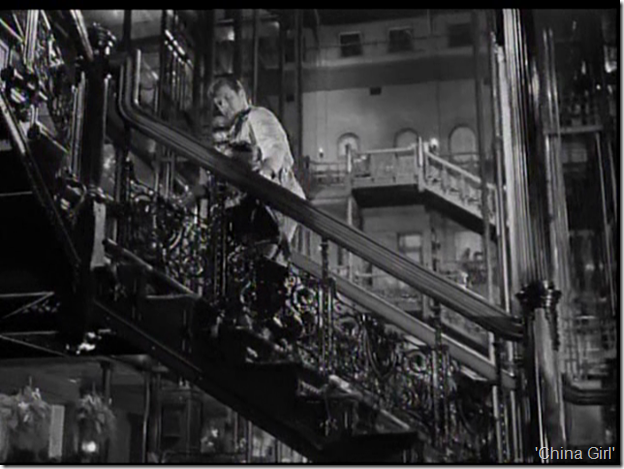
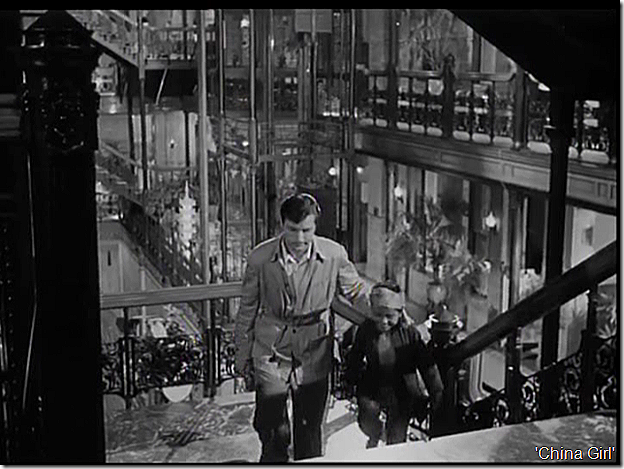
In this sequence, the space looks far too large to be the atrium of the Bradbury Building.
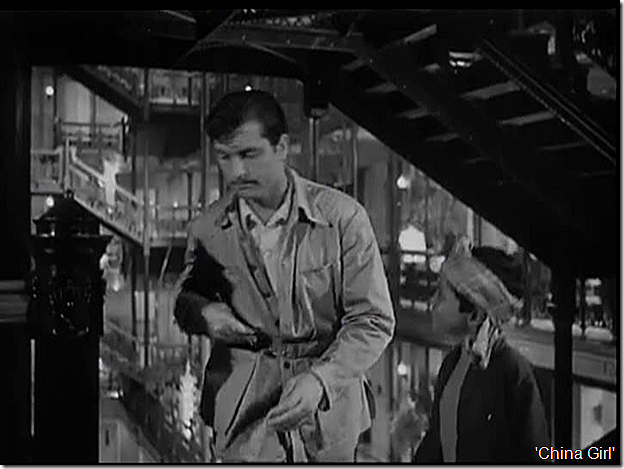
I’m really starting to think this is a set.
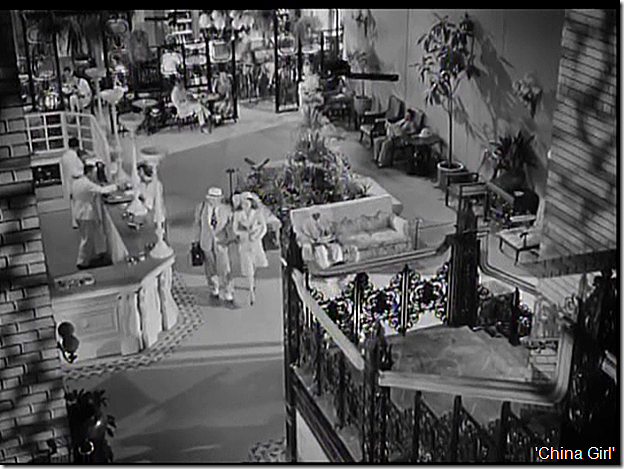
There is no way this could be the atrium of the Bradbury Building. It looks to me like a set by art directors Richard Day and Wiard B. Ihnen with set decoration by Thomas Little and Walter M. Scott.

[Update: For comparison, here’s a shot from “The White Cliffs of Dover.” Notice how much narrower the atrium appears in this shot.]
Another good story ruined!


Art director Wiard B. Ihnen was the longtime husband to costume designer Edith Head. The movie shows up on Fox Movie Channel. Not one of Gene Tierney’s best, but still fun….she plays the China Girl!
LikeLike
Actually, it could make sense ‘to film most of the scenes on a set and go to the Bradbury for a couple of pickup shots’. Especially if the set had been struck when they decided they needed those pickup shots. Far easier to rent the location one evening than to rebuild the entire set. Such things do happen.
LikeLike
Maybe they just knocked down a few walls. Case closed?
Seriously, your sleuthing is first rate. I have found myself becoming more and more of a background junky; paying attention to backgrounds and “extras.” I thought I was alone.
This investigation is among your best.
LikeLike
@Lee: Thanks!
LikeLike
When in doubt check the lighting. The open waiting room area is a very large space, yes, larger than the Bradbury, and they are pouring mega wattage into it. Notice in foto 3 that there is a dramatic slash of afternoon sunlight, and in foto 4, behind Lynn Bari, the same. Considering the time needed to shoot the two shots …camera moves, make up touch ups, props, etc, that slash of light had to stay put …therefore it is a “brute” so called. Could the B Bld accomodate that? In foto 5 Tierney and the desk clerk each apppear to be lit with different sources, as are the two flanking candleabra. In foto 6, the establishing shot of that scene, look at the thousands of crossing shadows on the floor. This is studio lighting at its worst …compare to any John Ford film. I agree: a set with tremendous space surrounding it for muchisimo lighting instruments. Next question: did the set happen to resemble the Bradbury, a possible back up, or was the B simply a fortuitous look a like when more shots were needed? There is the old adage I learned on my first day on the set: If they’re looking at the set they ain’t watching the film! Your close study was not anticipated.
LikeLike
@Gary: My best guess is that the art directors based the design on the Bradbury Building. And, really, they did a great job. Until now the set of “China Girl” has been mistaken for the Bradbury Building and is listed in many books and other sources (including “Los Angeles Plays Itself”) as one of the earliest film appearances of the building.
LikeLike
In the last foto from China Girl a similar look down into the lobby is missing most of the confusing shadows. I’d guess that as the wall to the right can now be seen that it was put into place to close off the set which meant that a lot of the lights that had been positioned there were lost.
LikeLike
I watched the first few minutes of the movie, and thought that the lobby scenes were shot a set and the shots of stairways and the upper floor were shot at the Bradbury buidling. Robert Blake may remember details about the movie, although he was only 9 when it was filmed.
LikeLike
“filming locations” are usually accurate & include small footage locations. I have checked this site many times for this sort of info. In “China Girl”, they simplysay it was filmed at the studio.
http://www.imdb.com/title/tt0034593/
Filming Locations:
20th Century Fox Studios – 10201 Pico Blvd., Century City, Los Angeles, California, USA
LikeLike
I am afraid IMDB does have a lot of mistakes in their “facts”–especially in quotations from films. The IMDB is a wiki, so contributors can be inaccurate or mistaken. In this case Larry has proven it was filmed at the 20th Century Fox Studios than to go the the Bradbury Building. As film lighting and cinematography technology improved, buildings like the Bradbury could be used as location shoots without cumbersome equipment taking up valuable space. And “China Girl” was not a big budget film. Thank you, Larry, for your outstanding research!
LikeLike
Even the still from “The White Cliffs of Dover” could represent a studio set foreground with rear screen projection for everything beyond the first landing. Such tricks were widely used in the era until things got highly mobile from the Sixties on. Those wonderful illusions of reality heightened the real. Still do.
LikeLike
This is he most logical explanation. Rear projection was used widely in early film production.
LikeLike
Although I can’t visit the Bradbury Building in person, I’ve looked at some web shots of the iron work, and there is more than one design for the balconies and stairwells. Look at the stairwell design in this website (http://www.tedsimages.com/text/dtlahist.htm) and you’ll see the elongated central design of the metal on the stairwell. It’s very confusing without actually seeing it in person and trying to compare the actual building to the movie’s upward shots of the stairs and balconies.
LikeLike
@Sarah: The public isn’t allowed past the first floor. I’ve never seen the upper floors.
LikeLike
Bummer. We’ll probably never know for sure.
Thanks for all your work. This is really interesting.
LikeLike
If your press card can’t get you in, make an appointment with someone on the top floor and walk down after.
LikeLike
I believe that the lobby was shot on the set and the stairway/interior shots are at the Bradbury Building.
In the lobby most of the walls are plaster and the grillwork between the bar and the lobby is the only element that looks remotely like the Bradbury.
However, the brick wall and the grillwork of the stairs at the end of the lobby look like the Bradbury! Why would they make the rest of the lobby totally unlike the Bradbury (excluding bar grill) but make the stairs exactly like the Bradbury unless they were also planning to shoot in the Bradbury?
China Girl was filmed in 1942 after the start of the war. Construction supplies would have been in scarce supply and it is unlikely that the studio would build such a extravagant set just for some shots of people going up and down stairs.
As Gary Martin said, check the lighting. The shot where Jean Tierney and George Montgomery are walking down the stairs they are being hit by a blast of light from the right. It’s so strong it casts hard shadows on the wall of the staircase. Sure doesn’t look like studio lighting.
But anyhow, the Bradbury building is a incredible treasure!
LikeLike
We may not have the definitive answer, but the exploration has revealed much about the process of filmmaking in the grand studio era. And how wonderful it is that the Bradbury Building still shines like a beacon all these years later.
Much appreciated.
LikeLike
The Bradbury was also featured in the “Demon With Glass Hand” episode of “Outer Limits”
LikeLike
“I believe that the lobby was shot on the set and the stairway/interior shots are at the Bradbury Building.”
Yep. This.
LikeLike
I know I am late to the party, but I just saw “China Girl” for the first time. I work in preservation architecture, sometimes reconstructing missing historic building feature based on old photographs. I agree with Bartstar and Skip Entro, that the lobby was a set and the stair and atrium shots are at the Bradbury Building.
I looked at your photographs and others, and at the Historic American Buildings Survey (HABS) plans for the building. The building’s atrium is narrow on the ground floor, but opens up to twice the width on the upper floors. Including the width of the open balconies, the atrium is 47 feet across on the upper floors. Several of the scenes are shot on the upper floor balconies and looking up. I agree with you that the railing on the lower run of stairs does not match that of the building’s stairs, but the film’s railings on the upper floors match those in the building. The width of the building’s atrium could also have been visually enhanced by the type of camera lens used.
LikeLike
I haven’t looked at the post and photos in a while but as I recall, the details in the ironwork of the railings are noticeably different between the building and the movie.
LikeLike
Yes, I agree there is a difference on the first floor. On the first floor, which I believe was the large lobby they created as a set, the railings in the building are different from those shown in the film. However, the upper floors in the actual building have a different railing design from that of the first floor in the building (the upper floors have kind of a shield design in the center, and it is a two part design with a horizontal space in the middle). I believe the building’s upper floor railings are the same as the ones seen in the film, and that the upper floors of the actual building were used in the film.
LikeLike
Another late-night viewing of “China Girl” on TV sent me into research mode again. I noticed that the brickwork in the Bradbury Building has very fine mortar joints, and is a different bond pattern than that of the walls constructed as the first floor lobby set for the movie, which show much wider mortar joints.
I also found a couple of archival supports for use of the Bradbury Building as set for the film. One is the AFI page for the film, which notes:
“Bobby Blake was borrowed from M-G-M for the production, and that some scenes were shot on location at the Bradbury Building in downtown Los Angeles. According to studio publicity, a permanent airfield was built on the lot for filming because real airfields could no longer be photographed due to wartime restrictions.”
Additionally, an article from August 26, 1942, in the “Brooklyn Daily Eagle” discusses use of the building for the film extensively:
“Los Angeles Building Sets a Burma Scene Ornate Bradbury
— Structure Serves As a Far Eastern Hotel for Hecht Film
Hollywood could never have built as lavish and unusual a “set” as 20th Century-Fox Is now using for many scenes In “China Girl.”
The curious Ben Hecht, who is both writer and producer on the picture, found one of the most colorful landmarks of Los Angeles as a background for his film, though few Angelenos know about the site, which should be on every tourist’s “must” list. It is the Bradbury Building at 3d and Broadway in downtown Los Angeles. From the outside it is just a drab, old-fashioned office building, neglected under a coat of grime.
But inside it is an architect’s dream. It could be an Oriental or a Spanish castle of indefinite age. It looks like anything but an office building.
Its floors and wide stairs are of reddish Italian marble. Its balconies and balustrades of filigreed iron grillwork contrast with its light ceilings and high wainscoting of golden oak.
From anywhere in the building one can see every detail of its interior. The center of the structure is a huge court, six stories high, beneath the skylight roof. Off of balconies on the four sides of the court are the offices.
When Hecht and Director Henry Hathaway inspected the building they knew that they had found the greatest set of the year. A deal was made to rent the place each night for a week to film their sequences for “China Girl.” And at night they found the old place to be even more intriguing.
One L. L. Bradbury built the building in 1891 as the realization of a dream inspired by Mexican culture he had absorbed during his years south of the Rio Grande, where he made his fortune in gold and found his Indian wife. It was 51 years ago.
Though there is at least one tenant who has had space in the building for more than 35 years—he is a lawyer who occupies the same office his father, an early tenant, had occupied—there is no one to say what the building was meant to be.
Old Bradbury might have intended it to be a hotel because he built bathtubs in the washroom of each suite. And some of the rooms still contain the golden oak and tile fireplaces which comprised the building’s original heating equipment.
The ceiling of what is now the boiler room is delicately decorated. Before the days of boilers it was a dignified dining room.
It all fascinated Ben Hecht. But primarily it was ideally suited for what he needed in “China Girl.”
In the picture the Bradbury Building will be seen as the interior of an exotic Burmese hotel. On one of its grilled balconies the prop department installed palm and cafe tables and the casting office supplied Chinese extras. That was all that was needed to make the old place look like a corner of the Far East.”
I’m sorry to be so long-winded. Your site has the most interesting and thorough discussion of this topic.
LikeLike
Hey thanks!
LikeLike
Not long winded at all. Linda, thanks for the details.
LikeLike